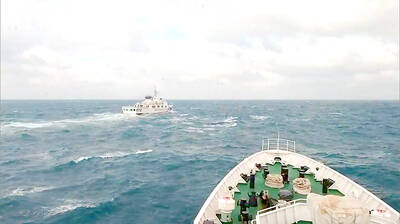The government is planning to reduce the size of the nation’s military to below 200,000 members by the end of 2019 as part of efforts to streamline it, Minister of National Defense Yen Ming (嚴明) said on Monday night.
According to a draft plan, the military will undergo downsizing from 2015 to 2019 under a draft plan, he said.
Under the streamlining program, “we plan to cut the number of troops to between 170,000 and 190,000,” from the 215,000 target for the end of this year, he said
The plan is part of the military’s effort to adjust the organization of the nation’s defense apparatus and restructure the armed forces, he said.
The plan has taken into consideration such factors as the type of combat operations in the future, government finances and the weapons in the military’s arsenal, Yen said, adding that the deployment of high-tech weapons systems would allow the military to cut its personnel.
This will also help achieve the goal of building a military force that is “small, but elite; small, but skillful; small, but strong,” he said.
Yen reiterated the government’s determination to shift to an all-volunteer force, citing measures aimed at giving young people more incentives to pursue a military career.
For example, since Jan. 1, the government has raised monthly allowances given to volunteer soldiers and non-commissioned officers to between NT$2,000 and NT$4,000 per month.
The government plans to shift to an all-volunteer force by 2017.
It originally planned for the transition to be completed by next year, but pushed the date back due to lower-than-expected recruitment numbers.
The military will need to recruit more than 10,000 servicemen annually next year and 2016, but that number will fall to about 7,000 beginning in 2017, Yen said.

Auckland rang in 2026 with a downtown fireworks display launched from New Zealand’s tallest structure, Sky Tower, making it the first major city to greet the new year at a celebration dampened by rain, while crowds in Taipei braved the elements to watch Taipei 101’s display. South Pacific countries are the first to bid farewell to 2025. Clocks struck midnight in Auckland, with a population of 1.7 million, 18 hours before the famous ball was to drop in New York’s Times Square. The five-minute display involved 3,500 fireworks launched from the 240m Sky Tower. Smaller community events were canceled across New Zealand’s

The Ministry of Foreign Affairs (MOFA) yesterday said it is closely monitoring developments in Venezuela, and would continue to cooperate with democratic allies and work together for regional and global security, stability, and prosperity. The remarks came after the US on Saturday launched a series of airstrikes in Venezuela and kidnapped Venezuelan President Nicolas Maduro, who was later flown to New York along with his wife. The pair face US charges related to drug trafficking and alleged cooperation with gangs designated as terrorist organizations. Maduro has denied the allegations. The ministry said that it is closely monitoring the political and economic situation

‘SLICING METHOD’: In the event of a blockade, the China Coast Guard would intercept Taiwanese ships while its navy would seek to deter foreign intervention China’s military drills around Taiwan this week signaled potential strategies to cut the nation off from energy supplies and foreign military assistance, a US think tank report said. The Chinese People’s Liberation Army (PLA) conducted what it called “Justice Mission 2025” exercises from Monday to Tuesday in five maritime zones and airspace around Taiwan, calling them a warning to “Taiwanese independence” forces. In a report released on Wednesday, the Institute for the Study of War said the exercises effectively simulated blocking shipping routes to major port cities, including Kaohsiung, Keelung and Hualien. Taiwan would be highly vulnerable under such a blockade, because it

UNRELENTING: China attempted cyberattacks on Taiwan’s critical infrastructure 2.63 million times per day last year, up from 1.23 million in 2023, the NSB said China’s cyberarmy has long engaged in cyberattacks against Taiwan’s critical infrastructure, employing diverse and evolving tactics, the National Security Bureau (NSB) said yesterday, adding that cyberattacks on critical energy infrastructure last year increased 10-fold compared with the previous year. The NSB yesterday released a report titled Analysis on China’s Cyber Threats to Taiwan’s Critical Infrastructure in 2025, outlining the number of cyberattacks, major tactics and hacker groups. Taiwan’s national intelligence community identified a large number of cybersecurity incidents last year, the bureau said in a statement. China’s cyberarmy last year launched an average of 2.63 million intrusion attempts per day targeting Taiwan’s critical